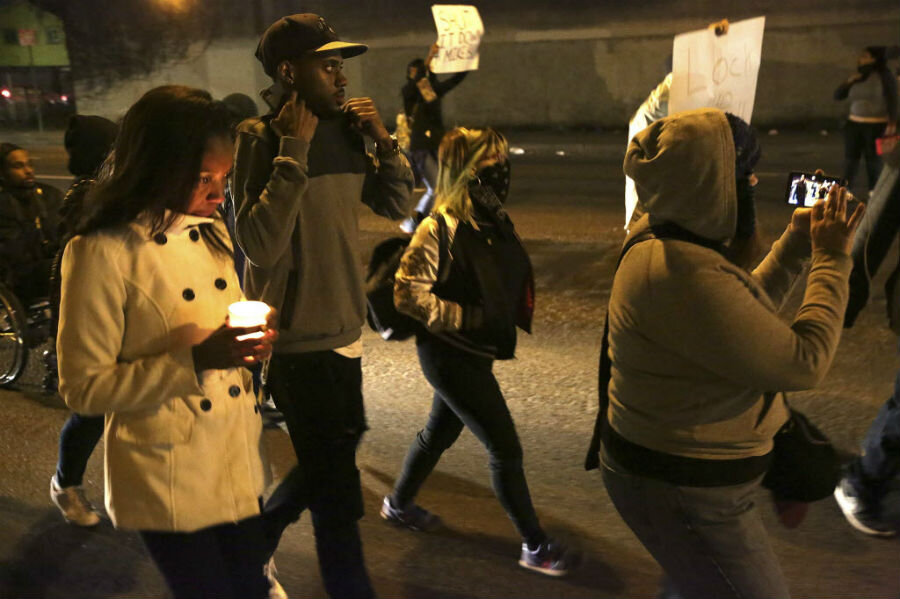Ezell Ford autopsy report: Four questions that remain unanswered
Loading...
| Los Angeles
A familiar scene played out in Los Angeles Monday night as small groups of protesters wielding placards reading, “No justice, no peace, no racist police,” spread out over the city. The demonstrations were spurred by the release of the long-awaited autopsy report of an August incident in which police shot and killed an unarmed African-American man.
The protesters shut down one key boulevard and a freeway for a few minutes each before being dispersed by police. They are urging the Los Angeles County district attorney to file criminal charges against the two LA Police Department officers involved in killing Ezell Ford.
“We are angry and we are going to stay angry for a very long time until this is addressed satisfactorily,” says Najee Ali, a well-known black activist and executive director of Project Islamic H.O.P.E. in Los Angeles.
He and other outraged residents are focused on one detail of the autopsy: that Mr. Ford was shot in the back.
“The killing of Ford has been ruled a homicide by the coroner, and the bullet wounds in his back give strong indication that he could not have been resisting the officers,” says Earl Ofari Hutchinson, president of the Urban Policy Roundtable of Los Angeles, one of the leading civil rights leaders in Los Angeles.
But others caution against drawing definitive conclusions from one detail.
“We should let the investigation take place without interference or inference. The autopsy is just one piece of investigative evidence, albeit a significant piece of evidence,” says Tod Burke, associate dean and professor of criminal justice at Radford University in Virginia.
LAPD Chief Charlie Beck said at a press conference that the wounds are consistent with the scenario described by his officers.
“There is nothing in the coroner’s report that is inconsistent with the statements given by the officers,” he said, adding, “The autopsy is a piece of much larger, more detailed investigation.”
Just after 8 p.m. on Aug. 11, Ford, whom his parents have said had been diagnosed with schizophrenia and bipolar disorder, was walking in South Central Los Angeles. Two officers got out of their car to speak with him. Ford looked at the officers, walked away, and attempted to conceal his hands, according to the LAPD account.
The officers followed Ford to a driveway, where he crouched between a car and a row of bushes, Chief Beck said. As one of the officers reached for him, Ford grabbed the officer and a struggle for the officer's gun began.
The police department delayed making the autopsy report public, claiming that doing so might influence the stories of any witnesses to Ford's shooting. Eventually, LA Mayor Eric Garcetti set a deadline of the end of the year for the report's release.
"I ordered the autopsy's release because transparency is key to the trust between the LAPD and the people they serve," Mayor Garcetti said in a statement Monday.
The report shows Ford was struck with bullets in the right arm, side, and back. There were abrasions on his left side, elbow, and shoulder.
Beck said a continuing investigation could take months. Meanwhile, national observers are weighing in on possible questions.
“One of the fatal wounds, the front to back wound in the flank, seems entirely consistent with a struggle at close range, especially – but not only – if the cop held the gun in his left hand,” says Joel Jacobsen, assistant attorney general for the criminal appeals division in New Mexico.
“The other fatal wound, the back to front one, is very strange. One thing I've learned about muzzle imprints is that they don't necessarily mean the muzzle was touching skin when the shot was fired, because the gun shoots out a lot of gas that can cause the skin to inflate. But if it wasn't a contact wound, it was fired from just millimeters away.”
He says some of the questions could include:
- If the flank shot wasn't at close range, then how do police account for one distant shot and one contact wound occurring simultaneously? “If Officer B was holding a gun to Ford's back, what was Officer A even shooting in their direction? That put Officer B in extreme danger,” says Jacobsen.
- Which fatal shot came first? “After the first, would Ford still have been able to act voluntarily or pose a threat? Not all fatal wounds are immediately incapacitating,” says Jacobsen.
- What is the timing of the shots? “If the shots weren't simultaneous, then it could mean that Ford fell onto his face after the flank shot and the back contact wound was a coup de grace,” he said.
But Islamic H.O.P.E.’s Ali says the most burning question of all will likely remain: Why was Ford stopped in the first place?
That question touches on the same vein that has spurred protests in the wake of two other high-profile police shootings of black men in Ferguson, Mo., and Staten Island, N.Y.
Even before the results of Ezell's autopsy were released Monday, tensions had been running high in Los Angeles. On Sunday night, two LAPD officers were shot at in what the LAPD has called an unprovoked attack.
Speculation has been widespread over whether or not the shootings were retaliation against police, such as was stated on social media by the alleged shooter of two Brooklyn policemen in their car a week ago. However, LAPD investigators have suggested that the shots may have been related to other gang activity.







